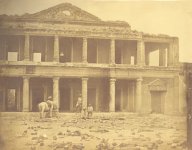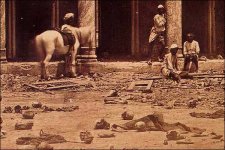xayraa33
rangefinder user and fancier
looking at the BBC news site this morning , and it showed a photo and drawing montage of the Indian Mutiny, as India is celebrating the 150 years since the Rebellion of 1857.
the opening photo was a crop of a photo that I had seen some 20 years ago in the book by Frances Fralin called " The Indelible Image😛hotographs of War 1846 to the present"
the photo was the interior of Secundra Bagh some months after the fighting by Felice Beato, it was gruesome and it stayed etched in my memory, but even 20 years ago I had a feeling that the corpses and bones and skulls were exhumed and placed in the courtyard for the benefit of the photographer , Felice Beato, to make a shocking & very memorable photo, which I think, he succeeded to do very well.
the BBC article today mentions this a bit, and it confirms my 20 year old gut feeling.
so this photo is similar to the dead rebel sniper of the American Civil War by Mathew Brady and Company.
there was accusation of the photograper placing the body near a rifle and calling the photo " dead rebel sniper ".
the opening photo was a crop of a photo that I had seen some 20 years ago in the book by Frances Fralin called " The Indelible Image😛hotographs of War 1846 to the present"
the photo was the interior of Secundra Bagh some months after the fighting by Felice Beato, it was gruesome and it stayed etched in my memory, but even 20 years ago I had a feeling that the corpses and bones and skulls were exhumed and placed in the courtyard for the benefit of the photographer , Felice Beato, to make a shocking & very memorable photo, which I think, he succeeded to do very well.
the BBC article today mentions this a bit, and it confirms my 20 year old gut feeling.
so this photo is similar to the dead rebel sniper of the American Civil War by Mathew Brady and Company.
there was accusation of the photograper placing the body near a rifle and calling the photo " dead rebel sniper ".



